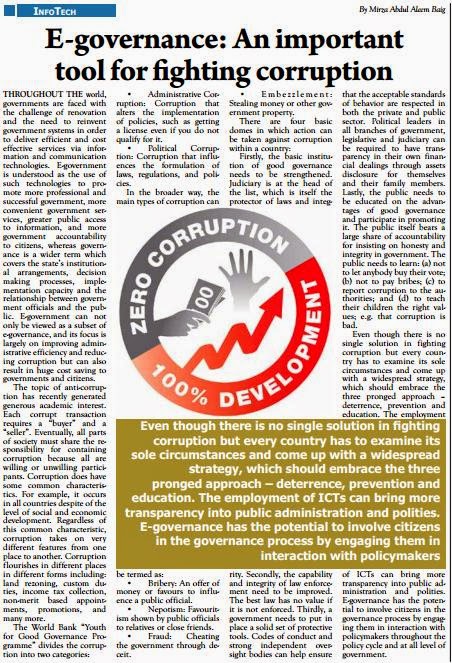Throughout the world, governments are faced with the challenge of renovation and the need to reinvent government systems in order to deliver efficient and cost effective services via information and communication technologies. E-government is understood as the use of such technologies to promote more professional and successful government, more convenient government services, greater public access to information, and more government accountability to citizens, whereas governance is a wider term which covers the state’s institutional arrangements, decision making processes, implementation capacity and the relationship between government officials and the public. E-government can not only be viewed as a subset of e-governance, and its focus is largely on improving administrative efficiency and reducing corruption but can also result in huge cost saving to governments and citizens.
The topic of anti-corruption has recently generated generous academic interest. Each corrupt transaction requires a “buyer” and a “seller”. Eventually, all parts of society must share the responsibility for containing corruption because all are willing or unwilling participants. Corruption does have some common characteristics. For example, it occurs in all countries despite of the level of social and economic development. Regardless of this common characteristic, corruption takes on very different features from one place to another. Corruption flourishes in different places in different forms including: land rezoning, custom duties, income tax collection, non-merit based appointments, promotions, and many more.
The World Bank “Youth for Good Governance Programme” divides the corruption into two categories:
• Administrative Corruption: Corruption that alters the implementation of policies, such as getting a license even if you do not qualify for it.
• Political Corruption: Corruption that influences the formulation of laws, regulations, and policies.
In the broader way, the main types of corruption can be termed as:
• Bribery: An offer of money or favours to influence a public official.
• Nepotism: Favouritism shown by public officials to relatives or close friends.
• Fraud: Cheating the government through deceit.
• Embezzlement: Stealing money or other government property.
There are four basic domes in which action can be taken against corruption within a country:
Firstly, the basic institution of good governance needs to be strengthened. Judiciary is at the head of the list, which is itself the protector of laws and integrity. Secondly, the capability and integrity of law enforcement need to be improved. The best law has no value if it is not enforced. Thirdly, a government needs to put in place a solid set of protective tools. Codes of conduct and strong independent oversight bodies can help ensure that the acceptable standards of behavior are respected in both the private and public sector. Political leaders in all branches of government, legislative and judiciary can be required to have transparency in their own financial dealings through assets disclosure for themselves and their family members. Lastly, the public needs to be educated on the advantages of good governance and participate in promoting it. The public itself bears a large share of accountability for insisting on honesty and integrity in government. The public needs to learn: (a) not to let anybody buy their vote; (b) not to pay bribes; (c) to report corruption to the authorities; and (d) to teach their children the right values; e.g. that corruption is bad.
Even though there is no single solution in fighting corruption but every country has to examine its sole circumstances and come up with a widespread strategy, which should embrace the three pronged approach – deterrence, prevention and education. The employment of ICTs can bring more transparency into public administration and polities. E-governance has the potential to involve citizens in the governance process by engaging them in interaction with policymakers throughout the policy cycle and at all level of government.



No comments:
Post a Comment